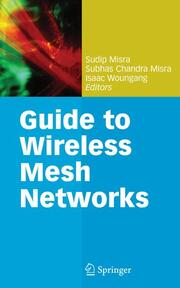-
Zusatztext
-
Overview and Goals Wireless communication technologies are undergoing rapid advancements. The last few years have experienced a steep growth in research in the area of wireless mesh networks (WMNs). The attractiveness of WMNs, in general, is attributed to their characteristics such as the ability to dynamically self-organize and self-con?gure, coupled with the ability to maintain mesh connectivity leading, in effect, to low set-up/installation costs, simpler maintenance tasks, and service coverage with high reliability and fault-tolerance. WMNs also support their integration with existing wireless networks such as cellular networks, WLANs, wireless-?delity (Wi-Fi), and worldwide interoperability of microwave access (WiMAX). WMNs have found u- ful applications in a broad range of domains such as broadband home networking, commercial/business networking, and community networking - particularly attr- tive in offering broadband wireless access with low initial installation and set-up costs. Even though WMNs have emerged to be attractive and they hold great promises for our future, there are several challenges that need to be addressed. Some of the wellknownchallenges areattributedtoissuesrelatingtoscalability(signi?cantdrop in throughput with the increase in the number of nodes), multicasting, offering qu- ity of service guarantees, energy ef?ciency, and security. This handbook attempts to provide a comprehensive guide on fundamental key topics coupled with new ideas and results in the areas of WMNs. The book has been prepared keeping in mind that it needs to prove itself to be a valuable resource dealing with both the important core and the specialized issues in WMNs.
-
-
Kurztext
-
Wireless communication technologies continue to undergo rapid advancement. The attractiveness of Wireless Mesh Networks (WMN)s, in general, can be attributed to their characteristics: the ability to dynamically self-organize and self-configure, coupled with the ability to maintain mesh connectivity, leads in effect to low set-up/installation costs, simpler maintenance tasks, and service coverage with high reliability and fault-tolerance. As a result, WMNs have found many useful applications in a broad range of domains. WMNs represent a key technology for future generation wireless networks, and this broad-ranging and comprehensive guidebook presents new ideas and results from research to address the challenges ahead. This unique resource describes all the fundamental key topics and covers both the important core and specialized issues in the field. Each chapter is written by topical area experts, with the first chapters devoted to the basics of WMNs and subsequent ones dealing with some of the more specialist topics, such as the WiMAX metro area mesh networks and the symbiosis of cognitive radio with WMNs. Features: Provides an accessible, comprehensive overview of the stateoftheart technology of Wireless Mesh Networks Includes readerfriendly discussions for practitioners, directions for future research, helpful lists of terms and definitions, and summary questions within each chapter Offers a set of questions to help readers assess their understanding of the various concepts at the end of each chapter Presents insight into the practical significance of these topics in realworld scenarios Designed, in structure and content, to aid the learning process with the intention of making the book useful at all learning levels Supplies supportive presentation PowerPoint slides and solutions to aid lecturers at www.springer.com/9781848009080 With contributions by some of the most prominent researchers in the field today, this book will be an invaluable reference/text to WMNs for researchers and practitioners. In addition, its pedagogical tools can make it eminently suitable as a textbook for graduate students wishing to learn more about the topic. Key Topics: WMNs and MANETs Medium Access Routing and Channel Assignment Routing Metrics Congestion and Transport Layer Issues Multinetwork Convergence and Scalability Mobility
-
Detailansicht
Guide to Wireless Mesh Networks
Computer Communications and Networks
ISBN/EAN: 9781849968041
Umbreit-Nr.: 1515068
Sprache:
Englisch
Umfang: xvi, 528 S.
Format in cm:
Einband:
kartoniertes Buch
Erschienen am 21.10.2010
Auflage: 1/2009


